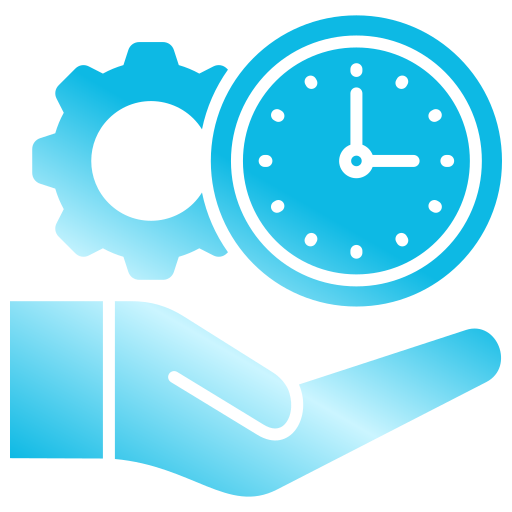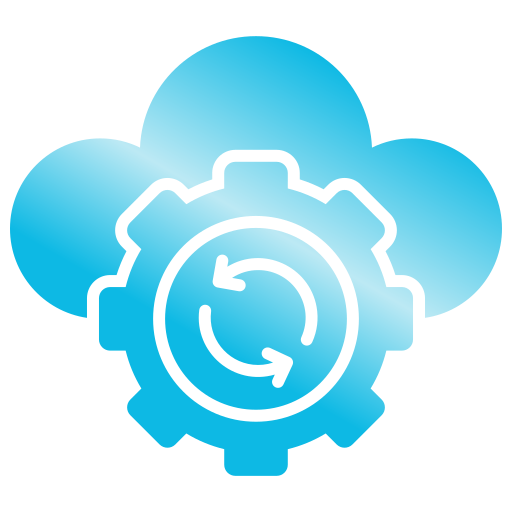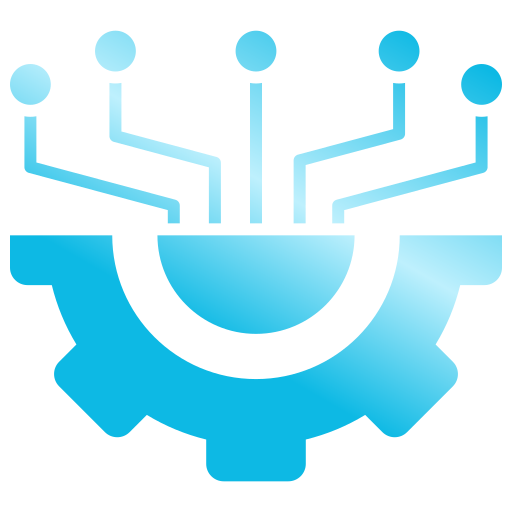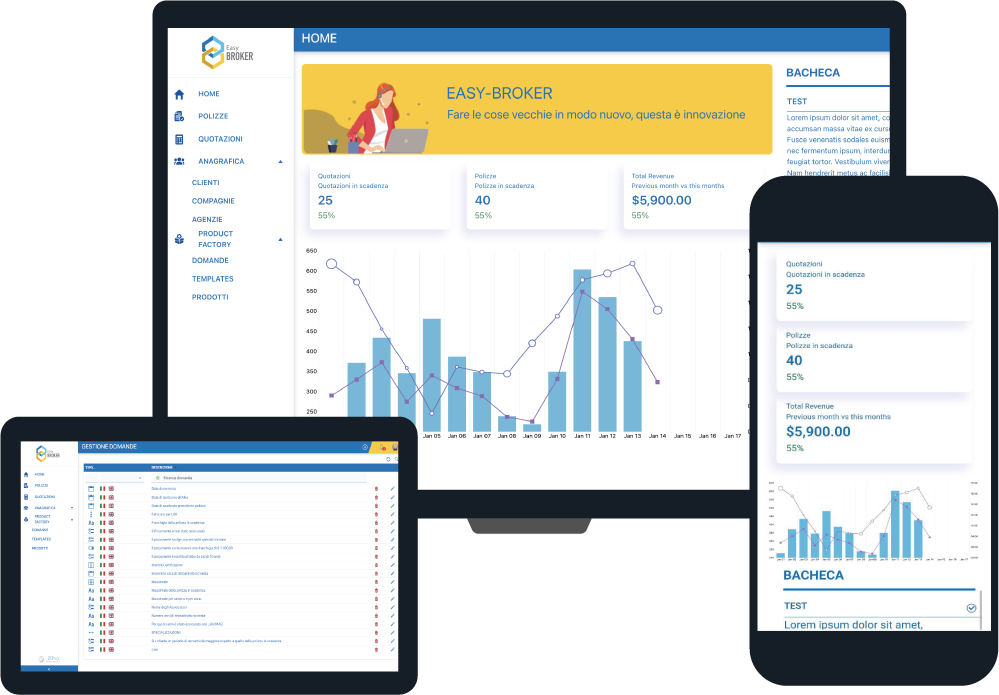EASY BROKER is an advanced software solution created in cooperation with a major industry player. Its main purpose is to simplify and optimise the entire insurance brokerage process, which involves the interaction between brokers, insurers and customers. An advanced software platform designed to simplify and optimise the entire insurance intermediation value chain. Its modularity, the collaboration with key players in the industry, its structured process management and task automation help improve the operational efficiency and quality of services offered by insurance intermediaries.
A TAYLOR-MADE SOLUTION
F L E X I B I L I T Y

The platform is structured in software modules that can be enabled and customised according to the needs of the individual customer. EASY BROKER can therefore be customised in every detail by adapting the framework to one’s own company business processes in order to obtain a tool that actually adheres to everyone’s working reality, with the support of our team of analysts and product specialists.
EASY BROKER is integrated with Lloyd’s DOPrint system and the systems of DAS Legal Defence and Zurich Assicurazioni for direct policy issuance.
I N N O V A T I O N

It is possible to create products by configuring questionnaires and rates through an advanced user interface that allows even complex rate calculations to be modelled using mathematical formulas or logical syntaxes. The quotation for the customer is made available during the filling in of the questionnaire and the opportunity is given to set up to three premium quotations with different coverage guarantees. The policy can be issued in real time or with the intervention of the insurance intermediary’s back office, depending on the availability of integration with the company’s services.
M O D U L E S
CORE
- Basis for interoperability of operational modules
This component is fundamental to ensuring that different operational modules can communicate and work together harmoniously within a system. In other words, it acts as a ‘lingua franca’ that enables these modules to exchange data and information efficiently.
- Automation and Coordination
This module plays a key role in automating processes and coordinating the activities of the various application modules. This means that it can manage planned actions and ensure that each module performs its task at the right time and in the right order.
- Insurance Lifecycle Management
An important aspect of its function is to manage the entire insurance lifecycle. This includes the acquisition of new customers, policy management, claims settlement and more. The module takes care to ensure that each of these phases is managed consistently and efficiently.
- Platform Modularity
The platform on which this module operates is designed in a modular manner. This means that individual modules can be activated or deactivated according to specific customer requirements. This flexibility allows the system to be adapted to the particular needs and preferences of each user, avoiding one-size-fits-all solutions.
ACCOUNTING
- Accounting Flow Management
The module is designed to manage and automate the flow of accounting data within an organisation. This includes the recording of financial transactions, the generation of accounting documents, record keeping and the management of all aspects of accounting.
- Integration with Third Party Systems
This module is able to connect and interact with other external systems or applications that are used by the company. This integration may include human resources management systems, inventory management systems, invoicing systems and so on.
- Use of Web Services
To enable integration with third-party systems, the module uses Web Services. Web Services are standard protocols for communication and data exchange between software applications on different networks. Using Web Service, the module can send and receive data securely and efficiently to and from other applications.
- Process Automation
One of the main features of this module is the automation of accounting processes. This means that many of the repetitive and manual tasks associated with accounting can be automated, reducing the risk of errors and increasing efficiency.
- Traceability and Auditability
The module usually offers complete traceability of all accounting activities. This means that it is possible to keep track of who made what changes and when, ensuring strict auditability of financial data.
- Reporting
The module can generate a wide range of financial and accounting reports based on the recorded data. These reports can be used for decision-making, financial reporting and regulatory compliance purposes.
POLICIES
- Dedicated module
This is a specific application or section within a system or software dedicated to the management of customer insurance policies.
- Customer policy portfolio management
This module focuses on the management of insurance policies held by a customer or group of customers. It can be used by insurance agents, insurance companies or brokers.
- Complete automation of maturity monitoring
One of its main functions is the automation of the policy maturity monitoring process. This means that the system keeps track of policy expiry dates and sends automatic alerts when policies need to be renewed or changes made.
- Appendices management
The module allows you to manage appendices to policies. Appendices are documents that add to or change the conditions of an existing policy. The system can manage the registration, review and storage of these appendices efficiently.
- Claims management
Another important functionality is claims management. This involves the recording and monitoring of possible claims from customers. The module can automate the process of registering claims, communicating with policyholders and managing investigations and payments.
CLAIMS
- Opening the Claims File
Start by registering the claim in the system. This can be done manually or be automated through online reporting by the customer or third parties such as police forces or hospitals. Basic initial information is captured, such as the date and time of the accident, details of the vehicles involved, the names of the people involved and any witnesses.
- Allocation of Expertise
Once the file is opened, the system can automatically assign the case to an adjuster or team of adjusters based on their availability and expertise. Appraisers receive instant notifications or online access to case details, including documents, images and previously collected information.
- Examination and Evaluation
Loss adjusters examine the file, often visiting the accident site or requesting additional information and documentation. They use digital tools to record the damage and assess its extent, determining liability and establishing the cost of repair or the value of the damage.
- Document Management
The module enables the digital management of all relevant documents, such as expert reports, medical documents, witness statements and correspondence with the parties involved. These documents are stored in an organised manner and can be easily retrieved at any time.
- Liquidation of Damage
After completing the analysis, the module supports the damage settlement process. It calculates the amount to be paid based on the expert assessments and the insurance policies involved. It automatically generates the necessary documents for payment to the beneficiary, such as cheques or transfers.
- Monitoring and Reporting
Throughout the process, the system allows real-time monitoring of the status of the file. It generates useful reports and statistics to assess the performance and efficiency of the claims management process, helping to identify any areas for improvement.
- Long Term Archiving
Once the file has been completed, the module can securely archive all claim data for future reference and to meet any document retention requirements.
CRM
- CRM
CRM is an acronym that stands for ‘Customer Relationship Management’ and represents a software system designed to manage customer relationships and company-customer interactions. In this context, CRM is a specific module implemented to facilitate all related activities.
- Dedicated Module
This is a specific part of a larger system or software. In this case, the module is dedicated to the management of particular aspects, i.e. the dynamics and relationships associated with the insurance process.
- Dynamics and Relations Management
This module focuses on the management of relationships between different entities involved in the insurance business. These entities might include insurers, agents, brokers, and of course the customers themselves. Dynamics management involves monitoring the interactions and transactions between these entities.
- Customer Autonomy
This is a crucial point. Customer autonomy means that the customer has complete control over their interactions and information related to their insurance policy. This means that the customer can access the system, view their policy details, make changes, request assistance or report claims independently, without necessarily having to go through an intermediary or operator.
PRODUCT BUILDER
- Dedicated module
This is a specific component or section within a platform or software system whose main purpose is to address a specific function or activity, in our case, the creation and management of insurance products.
- Creation and management of insurance products
This module focuses on the ability to create new insurance products and manage existing ones. This may include defining product characteristics, coverage options and other relevant details.
- Configuration Wizard
This is a guided process or virtual assistant that helps users, in this case customers, to perform certain actions or tasks in a structured and intuitive way. In the context of insurance products, the configuration wizard helps customers to easily create or customise their insurance policies.
- Questionnaires and Tariff
During the configuration process, customers may have to answer questionnaires or provide relevant information to determine their insurance needs. The ‘tariff’ refers to the cost of insurance, which may vary depending on the details provided by customers.
- Aimed at total customer autonomy
This module is designed to allow customers to act independently without the need for external intervention or assistance. Users can use the module to create, customise and manage their insurance policies independently, without having to depend on third parties.
- On the platform
This suggests that the module is an integral part of a broader platform, presumably an online insurance service platform or a software system dedicated to insurance management.
QUOTES
- Dedicated quotation management module
This module is a specific component of a system or software designed to manage the quotation process in insurance. Its main function is to create, manage and process quotations for insurance policies.
- Enabling a set of products for each producer
This functionality allows administrators or authorised users to associate a specific set of insurance products to each producer. In practice, a manufacturer or insurance agent may only offer a specific selection of policies, rather than the entire catalogue, thus simplifying the quotation process.
- Multi-version with the possibility of obtaining several quotes
The multi-version functionality allows users to create different versions of an insurance quote. This can be useful when you want to explore different options or compare different insurance coverage configurations. For example, several versions could be created to evaluate the cost and coverage details according to various customer requirements.
- Pricing Engine for real-time insurance premium calculation
The ‘pricing engine’ is a sophisticated component that performs complex calculations to determine the insurance premium based on the specific details provided in the quote. This engine can take into account multiple factors, such as the customer’s age, vehicle type, place of residence and other relevant factors. The ability to calculate the premium in real time means that users can immediately obtain an accurate estimate of the cost of their insurance policy without having to wait.
BUSINESS INTELLIGENCE
- Purpose of the Module
The module is designed to assist corporate management in analysing business intelligence data in real time. This means it provides immediate and up-to-date access to critical information for making informed decisions.
- Interactive Dashboards
The module offers fully interactive dashboards that visually represent business data in a clear and intuitive manner. These dashboards allow management to have an instant overview of company performance.
- Navigability
The dashboards are designed to be fully navigable, which means that users can explore the data in detail. They can zoom in on charts or select specific time periods or areas of interest to obtain more in-depth information.
- Customised Filters
Users have the option of applying customised filters to dashboards. These filters allow users to focus on specific data or perform comparative analysis based on user selections. For example, it is possible to filter data by region, department or time interval.
- Support for corporate KPIs
The module is designed to monitor corporate KPIs (Key Performance Indicators). This means that you can visualise the most relevant metrics for business success, such as sales, profitability, customer satisfaction, etc., in real time.
- Real-Time Reporting
In addition to dashboards, the module also allows browsing of real-time reporting data. Users can access instantly updated reports without having to wait for manual data processing.
H I G H L I G H T S

Software as a Service

B2B integration via SOAP and REST Web Services

Customisable according to customer requirements

Developed according to customer requirements

Always there for modification and support



